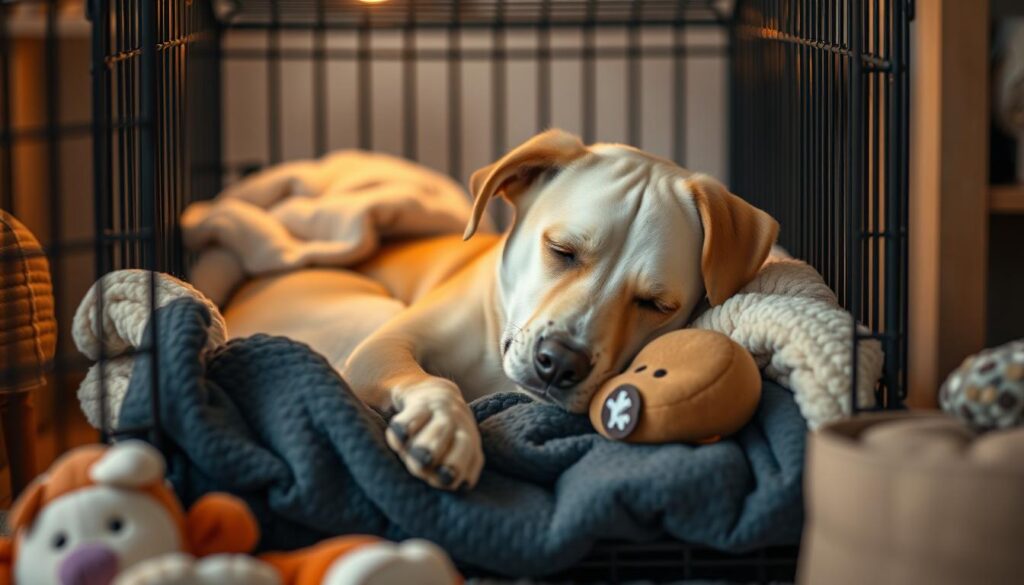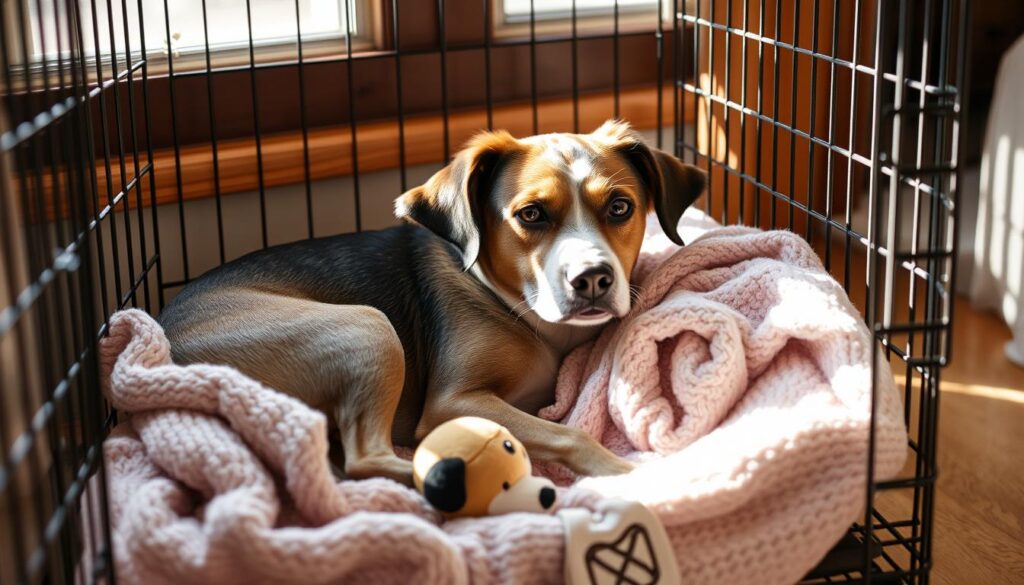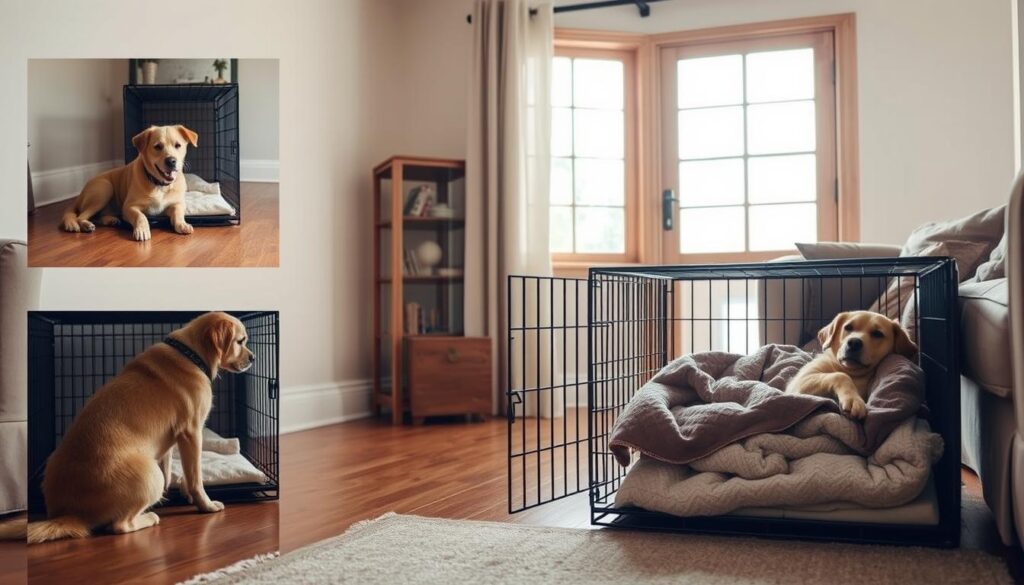How to Crate Train an Older Dog: A Compassionate, Powerful Guide
How to Crate Train an Older Dog . As a devoted dog owner, I’ve faced the challenges of crate training my senior pup. It was tough, but the benefits are huge. Crate training gave my aging dog a sense of security and comfort.
It also made travel, vet visits, and daily life easier. If you want to crate train your older dog gently and effectively, this guide is for you.
Key Takeaways
- Crate training older dogs requires patience and a positive approach, but the benefits are well worth the effort.
- Properly sized crates and a comfortable, familiar environment can make the transition seamless for senior pups.
- Gradual acclimation and consistent routines are the keys to successful crate training with older dogs.
- Addressing any resistance or anxiety issues with care and understanding is crucial for a positive experience.
- Nighttime crate training can be a game-changer for housebreaking and overall behavioral improvement.
Understanding the Benefits of Crate Training Senior Dogs
Crate training an older dog can offer many benefits. It can make them feel safer and more secure. It also helps during travel and vet visits. As dogs get older, crate training becomes even more important for their health.
Safety and Security Benefits
Senior dogs may move less or think less clearly. A crate can keep them safe from dangers like stairs or hot spots. It gives them a cozy place to rest and feel safe.
Anxiety Reduction Advantages
Crate training can also reduce anxiety in older dogs. This can happen during storms or fireworks. The crate’s familiar feel helps them relax and feel safer.
Travel and Veterinary Visit Preparation
Crate training helps senior dogs get ready for trips and vet visits. These can be tough for them as they age. By making crate time positive, like with treats, they learn to enjoy it.
In summary, crate training is great for older dogs. It boosts their safety, reduces anxiety, and makes travel and vet visits easier. With gentle training and rewards, it can greatly improve their quality of life.
Selecting the Right Crate Size and Type for Your Adult Dog
Choosing the right crate size and type is key for your older dog’s comfort and safety. The crate should be big enough for your dog to sit, stand, and lie down. But it shouldn’t be too big, as that might make them go to the bathroom inside.
To find the right size, measure your dog from head to feet for height, and nose to tail for length. Add 3 to 4 inches to each measurement. This ensures your dog has enough room to move without feeling cramped.
There are many crate types, like plastic, metal, wood, and fabric. The right material depends on your dog’s chewing habits, the crate’s use, and your preferences. Plastic crates are good for indoor use and flying. Metal crates are best for chewers. Wooden crates look nice but are heavy and hard to clean. Fabric crates are cheap and good for small, non-chewing dogs.
| Crate Type | Advantages | Disadvantages |
|---|---|---|
| Plastic | Suitable for indoor use and air travel, well-ventilated, durable | May not be as visually appealing |
| Metal | Suitable for chewers, good air circulation and visibility | May not be as aesthetically pleasing |
| Wood | Aesthetically pleasing, can double as furniture | Heavier, require assembly, challenging to clean |
| Fabric | Cost-effective, lightweight, simple to assemble, and fold down for storage | May not be as durable or easy to clean |
Every crate needs holes or mesh for air. Adding a comfy, washable bed makes the crate more appealing and cozy for your senior dog.
By picking the right crate size and type, you make a safe, cozy space for your dog. This helps them feel secure during crate training.
Creating a Comfortable Crate Environment
Creating a cozy and secure crate is key for older dogs to feel at ease. The crate should be a safe haven for your senior pet. It should promote relaxation and comfort.
Essential Crate Accessories
Put soft, orthopedic bedding in the crate for a comfy resting spot. Add your dog’s favorite toys or a familiar blanket to make them feel at home. If needed, include a water bowl to keep them hydrated while crated.
Optimal Crate Placement
Choose a quiet, low-traffic spot for the crate. Stay away from busy areas that might stress or distract your dog. Place the crate near where you sit or sleep to make your dog feel part of the family.
Temperature and Comfort Considerations
Keep the crate at a comfortable temperature, not too hot or cold. Good ventilation is also important for a healthy, pleasant space for your senior dog. Watch your dog’s behavior and adjust the crate’s spot or accessories as needed for the best experience.
By focusing on your older dog’s comfort and safety in the crate, you create a crate as a safe space for older pets. They will learn to associate it with relaxation and security.
How to Crate Train an Older Dog
Crate training an older dog is a bit different than training a puppy. But it’s still a great way to give your dog a sense of security. The key is to go slow and use positive reinforcement. Here’s a step-by-step guide to help you crate train your adult or senior dog successfully.
First, make sure your dog has had enough exercise and gone to the bathroom. This will help them feel calm and ready for the crate.
- Start by letting your dog get used to the crate. Use treats or toys to make it a positive experience. Let them explore the crate at their own pace, rewarding them with praise and treats.
- When your dog is comfortable, start closing the door for short times. Gradually increase the time. Use a cue like “kennel up” to signal it’s time to go in the crate.
- Make the crate a cozy space. Add comfortable bedding, familiar toys, and even a piece of your clothing. This will help your dog feel safe and comfortable in the crate.
Remember, patience and consistency are crucial when crate training an older dog. They may take longer, but with time and positive reinforcement, they’ll learn to love their crate.

If your dog shows signs of resistance, like whining or scratching, take a break. Try again later. If they’re still resistant, check for any underlying issues like anxiety or health problems. With the right approach, your older dog will feel safe and secure in their crate.
Building Positive Associations with the Crate
Crate training can make your older dog feel safe and comfy. It’s all about making the crate a good place with food, treats, and toys. This way, your senior dog will love their crate.
Using Food and Treats
Start by giving your dog meals in the crate with the door open. This makes the crate a positive spot for meals. You can also put small treats in the crate for your dog to find. As they get used to it, keep them in the crate longer while they enjoy these treats.
Incorporating Favorite Toys
Put your dog’s favorite toys, chews, or puzzle feeders in the crate. This makes the crate a fun, not scary, place. Change the toys often to keep your dog excited about the crate.
Progressive Reward Systems
- Start by giving a small treat for just going near the crate.
- As they get more comfortable, give bigger rewards for entering or staying in the crate.
- When they’re really confident, use their favorite snacks or playtime to show the crate is great.
Using positive reinforcement crate training helps your older dog love their crate. Be patient and consistent for the best results.
Establishing a Consistent Crate Training Schedule
Training an older dog to use a crate needs a steady, structured plan. Start by putting them in the crate during their natural rest times, like after eating or playing. This makes the crate feel like a cozy part of their routine.
As your dog gets used to the crate, slowly add more time to their crate sessions. This slow introduction helps them see the crate as a safe place. Keeping a regular crate schedule helps them stay positive about it.
- Incorporate crate time during your dog’s natural rest periods, such as after meals or playtime.
- Gradually increase the duration of crate sessions as your dog becomes more comfortable.
- Maintain a consistent crate training schedule to reinforce positive associations.
Being patient and consistent is the secret to crate training an adult dog. By sticking to a plan and slowly introducing them to the crate, you make them feel safe and secure. This is good for their happiness and can also make your life easier, especially when you need to take them places in a crate.
| Crate Training Tip | Benefit |
|---|---|
| Align crate time with your dog’s natural rest periods | Reduces stress and creates positive associations |
| Gradually increase crate duration over time | Allows your dog to become comfortable at their own pace |
| Maintain a consistent crate training schedule | Reinforces positive habits and associations |

“Patience is key in crate training, with Wag suggesting it can take months to crate train a puppy and potentially longer for rescue dogs.”
Common Challenges and Solutions in Adult Dog Crate Training
Training an adult dog to use a crate can be tough. But, with the right steps, you can help them get used to it. One big problem is if the dog doesn’t want to go in the crate. This might be because of bad past experiences or just not liking the crate.
To fix this, take it slow and make the crate a good place. Use treats and praise to show the dog it’s a positive space.
Dealing with Resistance
If your dog doesn’t want to go in the crate, be patient. Let them get used to it at their own pace. Make sure they see the crate as a good thing, like a place for treats or praise.
Don’t force them into the crate. This can make them even more scared and resistant.
Managing Anxiety Issues
Anxiety is a big problem for some dogs in crate training. They might whine, pace, or try to get out. To help, use calming tools like white noise or pheromone diffusers.
Make sure the crate is comfy and welcoming. Add their favorite bedding and toys to make it feel like home.
Overcoming Past Negative Experiences
If your dog had bad experiences with crates before, it’s hard to change their mind. Start by letting them see the crate as a safe space. Don’t make them go in it yet.
Slowly introduce crate time, making sure it’s always a good experience. Never force them into the crate.
If your dog still struggles, get help from a dog trainer or behaviorist. They can give you specific advice to help your dog feel comfortable in the crate.
Gradual Duration Building Techniques
Crate training an older dog is a slow but rewarding journey. With patience and consistency, your dog can learn to love their crate. Start with short times and gradually increase the crate time.
Begin by letting your dog get used to the crate for a few seconds. Reward them with treats or a stuffed Kong toy. This makes the crate a positive place. Then, slowly add more time, keeping your dog calm and relaxed.
- Start with short crate sessions of 5-10 seconds, gradually increasing to 1-2 minutes.
- Provide your dog with their favorite toys or chews to keep them occupied and content during longer crate times.
- Close the crate door for brief periods, slowly extending the duration as your dog becomes more comfortable.
- Monitor your dog’s body language and adjust the pace if they show signs of stress or anxiety.
The goal is to help your dog get used to the crate slowly. This step-by-step method makes crate training a success for your older dog.
“Patience and consistency are key when crate training an adult dog. Rushing the process can lead to setbacks, so take it slow and let your dog set the pace.”

Every dog is different, and crate training time varies. By using these techniques, your older dog will feel safe and comfortable in their crate.
Nighttime Crate Training Strategies
Crate training an adult dog is a slow process. Nighttime crating is a key part of it. To make it smooth and comfortable for your dog, try these strategies.
Begin by introducing the crate slowly. Place it in your bedroom first. This makes the crate a safe spot for your dog.
Make bedtime a routine. This can include a calm walk or playtime, followed by a potty break. This helps your dog feel ready for sleep.
Make sure your dog has enough exercise before bed. This prevents accidents and helps them sleep well. You can also use calming aids like pheromone diffusers or soothing music.
Once your dog gets used to the crate, move it to its final spot. Do this slowly. Let your dog get used to the new place and feel safe.
Remember, crate training an adult dog needs patience and consistency. With these strategies, your dog will feel safe and happy in their crate.
Conclusion
Crate training an older dog needs patience, consistency, and positive reinforcement. It offers safety, reduces anxiety, and makes travel and vet visits easier. Every dog is different, so the training might change. But, most older dogs can learn to see their crate as a safe and cozy place.
Training an older dog for the crate can make traveling less stressful. It gives them a sense of safety and security. It also keeps them out of danger and helps stop unwanted behaviors. This way, they have a space to feel safe and relaxed.
There are many crate types to choose from, like plastic, wire, and soft-sided crates. The right one depends on your dog. Introduce the crate slowly, using treats and familiar smells. A consistent routine and patience can make crate training a success for both dog and owner.
FAQ
Can older dogs be crate trained?
What are the benefits of crate training for senior dogs?
How do I choose the right crate size and type for my older dog?
How do I make the crate comfortable for my senior dog?
How do I gradually introduce the crate to my older dog?
How can I build positive associations with the crate for my older dog?
How do I establish a consistent crate training schedule for my older dog?
How do I address resistance or anxiety issues during crate training for my senior dog?
How can I gradually increase the duration of crate time for my older dog?
How do I introduce nighttime crating for my older dog?
Source Links
- How to Crate Train an Older Dog: Comprehensive Guide + Schedule – https://www.sniffspot.com/blog/dog-training/crate-train-an-older-dog
- Housebreaking Your Dog: Step By Step Process… – Brandon McMillan’s Canine Minded – https://canineminded.com/housebreaking-dog-step-step-process/
- How to Crate Train an Older Dog: Mastering Late-Life Obedience – https://roguepetscience.com/blogs/dog-training/how-to-crate-train-an-older-dog
- How to Crate Train an Older Dog? – https://basepaws.com/dog-insider/how-to-crate-train-an-older-dog?srsltid=AfmBOoqZx2x2cwUshrY7dGsl6jh1rQvlhCwMB2tMiYsLk7S_Zf9kteV8
- No title found – https://www.akc.org/expert-advice/lifestyle/choose-best-crate-dog/
- How to Choose the Perfect Dog Crate – https://be.chewy.com/dog-crate-buying-guide/
- Crate Training Your Dog | 10 Best Practical Steps – https://www.thedogkennelcollection.com/blog/crate-training/
- Crate Training Regression: Tips for Frustrated Dog Parents – https://www.impactdogcrates.com/blogs/news/crate-training-regression?srsltid=AfmBOorX_vILBaAmgwdSWPJyn0s23P1_UXLdRFNLg-o58wqKum4rGqAy
- How To Potty Train an Older Dog – https://www.petmd.com/dog/general-health/how-to-potty-train-older-dog
- How to Crate Train a Rescue Dog – Whole Dog Journal – https://www.whole-dog-journal.com/training/how-to-crate-train-a-rescue-dog/
- PDF – https://www.co.davis.ut.us/docs/librariesprovider14/information/karen-pryor-crate-training-guide.pdf?sfvrsn=e7f5f753_3
- How to Crate Train an Older Dog? – https://basepaws.com/dog-insider/how-to-crate-train-an-older-dog?srsltid=AfmBOopBdRJDz2qqeEDfEIPsmRLvKmn9ARYvqw08ox6AMY9zwDkMCFMz
- How To Crate Train A Rescue Dog Easily And Comfortably – https://rockcreekcrates.com/blogs/separation-anxiety-crates/teaching-your-rescue-dog-to-love-their-crate?srsltid=AfmBOoo8dOIETTNXvSs7yJvNGE-8Hk9N2jWCmYq0t-iTrJBuobeGYRmz
- How Old Should You Start Crate Training A Puppy? | L&L Info Hub – https://www.lordsandlabradors.co.uk/blogs/journal/how-old-should-you-start-crate-training-a-puppy?srsltid=AfmBOoppBsGsNWQjrFWR6jfZOhfudALrqXvQFb6SwWk8-oWAbsWKXZL_
- Great Pyrenees Crate Training: Mastering the Essentials for Your Gentle Giant – https://furlyfe.com/great-pyrenees-crate-training-mastering-the-essentials-for-your-gentle-giant/
- Crate Training Regression: Tips for Frustrated Dog Parents – https://www.impactdogcrates.com/blogs/news/crate-training-regression?srsltid=AfmBOopDLWZ-dJtka0qlVhq9OvK7Aok6qgNbDKnnjJJWxCOwoOJi7-jk
- 5 Tips for Crating a Dog with Separation Anxiety | Paw CBD – https://www.pawcbd.com/blogs/posts/five-tips-for-crating-a-dog-with-separation-anxiety
- How to Crate Train an Older Dog? – https://basepaws.com/dog-insider/how-to-crate-train-an-older-dog?srsltid=AfmBOopMSVjVvJ72E5x0DCuRDtVfjIhD5Pak-K9_d5-qeLmbhPfDpEBd
- Why and How to Crate Train Your Dog – https://bowwowfuntowne.com/crate-train-dog/
- Crate Training Your Puppy or Adult Dog — Happy Buddies – https://www.happy-buddies.co.uk/blog/crate-training-your-puppy-or-adult-dog
- Puppy Crying in His Crate? Here’s What To Do – https://www.petmd.com/dog/behavior/puppy-crying-in-crate
- How to Crate Train an Older French Bulldog: A Comprehensive Guide – https://www.frenchie.shop/blogs/frenchie-shop-blog/how-to-crate-train-an-older-french-bulldog-a-comprehensive-guide?srsltid=AfmBOopW7rr5NxoxpWdQKJxQJcXsXx9cXmZ22-GuRC0c3PqWcG_ynZVd
- How to Crate Train an Older Dog? – https://basepaws.com/dog-insider/how-to-crate-train-an-older-dog?srsltid=AfmBOorpDBbXAgVYEz6lRbv5shO0u8xDs4zqfR8SusDa0z7BV7wNDpvV
- Crate Training A Puppy – https://www.vetdogs.org/AV/E_and_N/Blog_Posts/Crate_Training_A_Puppy.aspx



